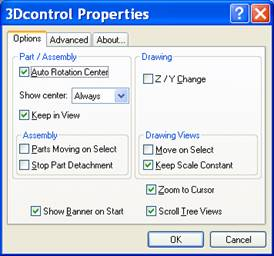There’s a Simpsons‘ episode where Homer discovers he has a successful half-brother named Herb Powell. Herb runs a car company. Herb is convinced that Homer represents the average American and is therefore the perfect person to design a new car for his company. Herb introduces Homer to his company’s design team. The design team ignore Home and instead use their experience to design perfect vehicle.
Homer is at first intimidated by the design team, but Herb feels that Homer is not being forceful enough with his ideas. Herb invigorates Homer. Homer then rejects the designers’ ideas and instead implements strange ideas like dual bubble domes, fins and several horns that play “La Cucaracha”. At the unveiling of new car, dubbed “The Homer”, Herb is horrified to discover that the car is a monstrosity that costs $82,000. Herb’s company goes under and he becomes broke.
What’s the lesson here? Have a focus when designing the next hot gadget. The design of the 3DConnexion SpacePilot PRO isn’t like “The Homer” in that it is sleek and functional. However, there does not seem to be a strong focus for the device. Is it a 3D mouse, or an Outlook companion, or a keyboard replacement, or an RSS feed reader? Right now, it is all of these things.
First, why does a control device have an LCD screen? If there was a need for me to see a status of something, then I can see why some sort of visual feedback would be necessary. There isn’t much of a need for that with this device, however. (Please see P.P.P.S below for notice of an update to this criticism.)
Second, on that LCD, I’m given the ability to open Outlook email, appointments and tasks. Given the fact that I have two monitors, this functionality is not needed for me. I keep Outlook open and in view on my second monitor all day anyway.
Third, why does this device give me RSS feeds? In my mind, the goal of a control device should be to not require the user to look at it while it is being used. That LCD screen bags to be looked at. Sometimes I feel bad that I’m not using it.
My criticism of the LCD is based solely on the fact that I have two monitors. For someone with a single monitor, I can see why this functionality would be useful and a real time saver.
I think that a future device that 3DConnexion should develop is a more compact version of the SpacePilot PRO without an LCD screen. Then bring in all the buttons closer to the control knob and place them under the most likely locations where one’s fingers will naturally land. Make sure all of the buttons are multi-function programmable (just like the SpacePilot PRO).
My bottom line, this device is worth the $499 price tag if there happens to be a need for an LCD screen with the ability to launch Outlook tools and read RSS feeds. I’m sure this device will save someone time and money (such as users with only one monitor). However, if I were to spend my own money, I would want a simpler device that is geared towards controlling my views within the model and shortcuting tasking within the 3D CAD environment. The SpacePilot PRO is a strong step in that direction, but it overreaches in other areas where there doesn’t seem to be much of a need (at least for me). When I am in the market to buy another 3D mouse, I would be interested in the hypothetical SpaceExplorer PRO with a more compact design, more multi-function programmable buttons, and better placement for the buttons. My price range would be in the area of $300, though 3DConnexion might hafta bring the price down to $199 (twice the price of high-end standard mice) to help sales take off.
I don’t represent the average American, nor do I feel I am the average 3D CAD user. I like my SpacePilot PRO, and will likely continue to use it. However, I can see where this might be a case of less is more. I’ve looked at the current generation of the SpaceExplorer and I actually think that it would be more ideal for one’s home office.
—-
P.S., why hasn’t the 3DConnexion control knob not been turned into a gaming controller yet? This seems like an obvious application for 3D mice. Speaking of other applications, this might not be a bad idea as a control mechanism for a navigation and center console control system in a car.
P.P.S., this device works awesomely in the main mode of Google Earth (though it would be nice for it to work in all modes withing Google Earth). They should really make a driver for Celestia.
P.P.P.S., I originally wrote this article before the recent update to the drivers for the SpacePilot PRO. With the recent update, my opinion about the LCD has changed a little bit. I’ll address this in a future article.


 According to 3DConnexion, their 3D mice now complement new SolidWorks 2010 functions such as Rapid Dimension Tool and Mouse Gestures. I’ve personally not had a chance to evaluate these improvements with my SpacePilot PRO (which was, as I stated in a
According to 3DConnexion, their 3D mice now complement new SolidWorks 2010 functions such as Rapid Dimension Tool and Mouse Gestures. I’ve personally not had a chance to evaluate these improvements with my SpacePilot PRO (which was, as I stated in a